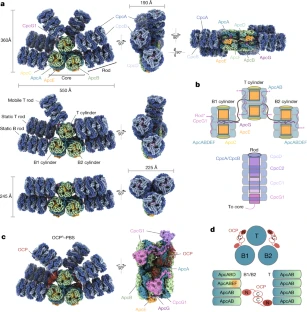Science Daily September 9, 2022
The cyanobacterial antenna structures, which are called phycobilisomes, are complex collections of pigments and proteins, which assemble into relatively massive complexes. Researchers have been unable to get the high-resolution images of intact antennae needed to understand how they capture and conduct light energy. An international team of researchers (USA – Michigan State University, Lawrence Berkeley National Laboratory, UC Berkeley, Czech Republic) documented several notable results, including finding a new phycobilisome protein, observing two new ways that the phycobilisome orients its light-capturing rods that hadn’t been resolved before, and the structure of the antenna is available with nearly atomic resolution. They discovered many surprises including how a relatively small protein can act as a surge protector for the massive antenna. The cyanobacteria are slow to turn their photoprotection off after it has done its job. Now, with the complete picture of how the surge protector works, researchers can design ways to engineer “smart,” less wasteful photoprotection. According to the researchers the study has provided a blueprint for tuning and optimizing the light-harvesting component of photosynthesis. The insights could help researchers remediate harmful bacteria in the environment, develop artificial photosynthetic systems for renewable energy and enlist microbes in sustainable manufacturing that starts with the raw materials of carbon dioxide and sunlight… read more. TECHNICAL ARTICLE

Structural overview of PBS and OCP–PBS from Synechocystis sp. PCC 6803.Credit: Nature (2022)